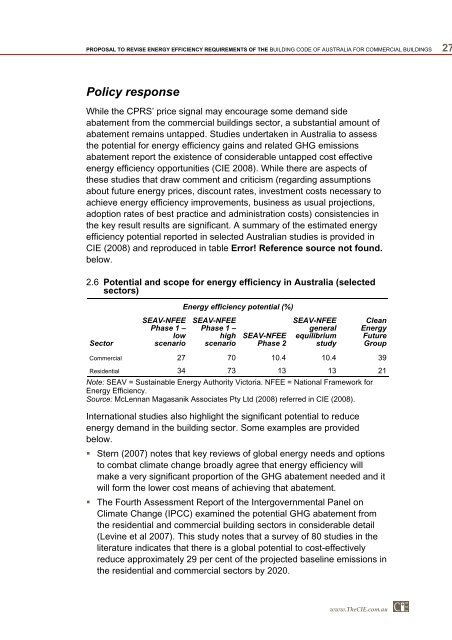PDF | 2 MB - Australian Building Codes Board
PDF | 2 MB - Australian Building Codes Board
PDF | 2 MB - Australian Building Codes Board
Create successful ePaper yourself
Turn your PDF publications into a flip-book with our unique Google optimized e-Paper software.
PROPOSAL TO REVISE ENERGY EFFICIENCY REQUIREMENTS OF THE BUILDING CODE OF AUSTRALIA FOR COMMERCIAL BUILDINGS 27<br />
Policy response<br />
While the CPRS’ price signal may encourage some demand side<br />
abatement from the commercial buildings sector, a substantial amount of<br />
abatement remains untapped. Studies undertaken in Australia to assess<br />
the potential for energy efficiency gains and related GHG emissions<br />
abatement report the existence of considerable untapped cost effective<br />
energy efficiency opportunities (CIE 2008). While there are aspects of<br />
these studies that draw comment and criticism (regarding assumptions<br />
about future energy prices, discount rates, investment costs necessary to<br />
achieve energy efficiency improvements, business as usual projections,<br />
adoption rates of best practice and administration costs) consistencies in<br />
the key result results are significant. A summary of the estimated energy<br />
efficiency potential reported in selected <strong>Australian</strong> studies is provided in<br />
CIE (2008) and reproduced in table Error! Reference source not found.<br />
below.<br />
2.6 Potential and scope for energy efficiency in Australia (selected<br />
sectors)<br />
Energy efficiency potential (%)<br />
Sector<br />
SEAV-NFEE<br />
Phase 1 –<br />
low<br />
scenario<br />
SEAV-NFEE<br />
Phase 1 –<br />
high<br />
scenario<br />
SEAV-NFEE<br />
Phase 2<br />
SEAV-NFEE<br />
general<br />
equilibrium<br />
study<br />
Clean<br />
Energy<br />
Future<br />
Group<br />
Commercial 27 70 10.4 10.4 39<br />
Residential 34 73 13 13 21<br />
Note: SEAV = Sustainable Energy Authority Victoria. NFEE = National Framework for<br />
Energy Efficiency.<br />
Source: McLennan Magasanik Associates Pty Ltd (2008) referred in CIE (2008).<br />
International studies also highlight the significant potential to reduce<br />
energy demand in the building sector. Some examples are provided<br />
below.<br />
• Stern (2007) notes that key reviews of global energy needs and options<br />
to combat climate change broadly agree that energy efficiency will<br />
make a very significant proportion of the GHG abatement needed and it<br />
will form the lower cost means of achieving that abatement.<br />
• The Fourth Assessment Report of the Intergovernmental Panel on<br />
Climate Change (IPCC) examined the potential GHG abatement from<br />
the residential and commercial building sectors in considerable detail<br />
(Levine et al 2007). This study notes that a survey of 80 studies in the<br />
literature indicates that there is a global potential to cost-effectively<br />
reduce approximately 29 per cent of the projected baseline emissions in<br />
the residential and commercial sectors by 2020.<br />
www.TheCIE.com.au
















